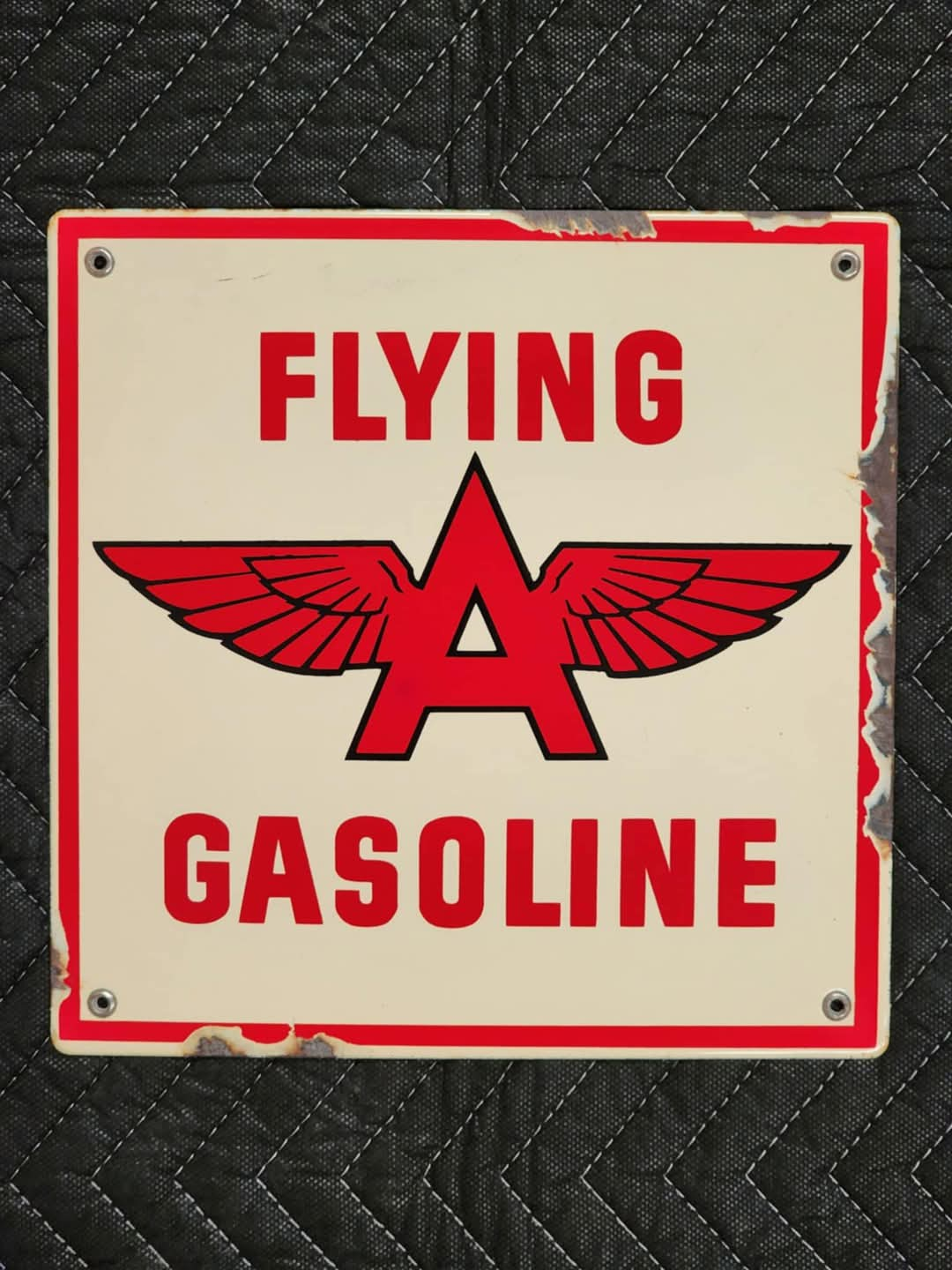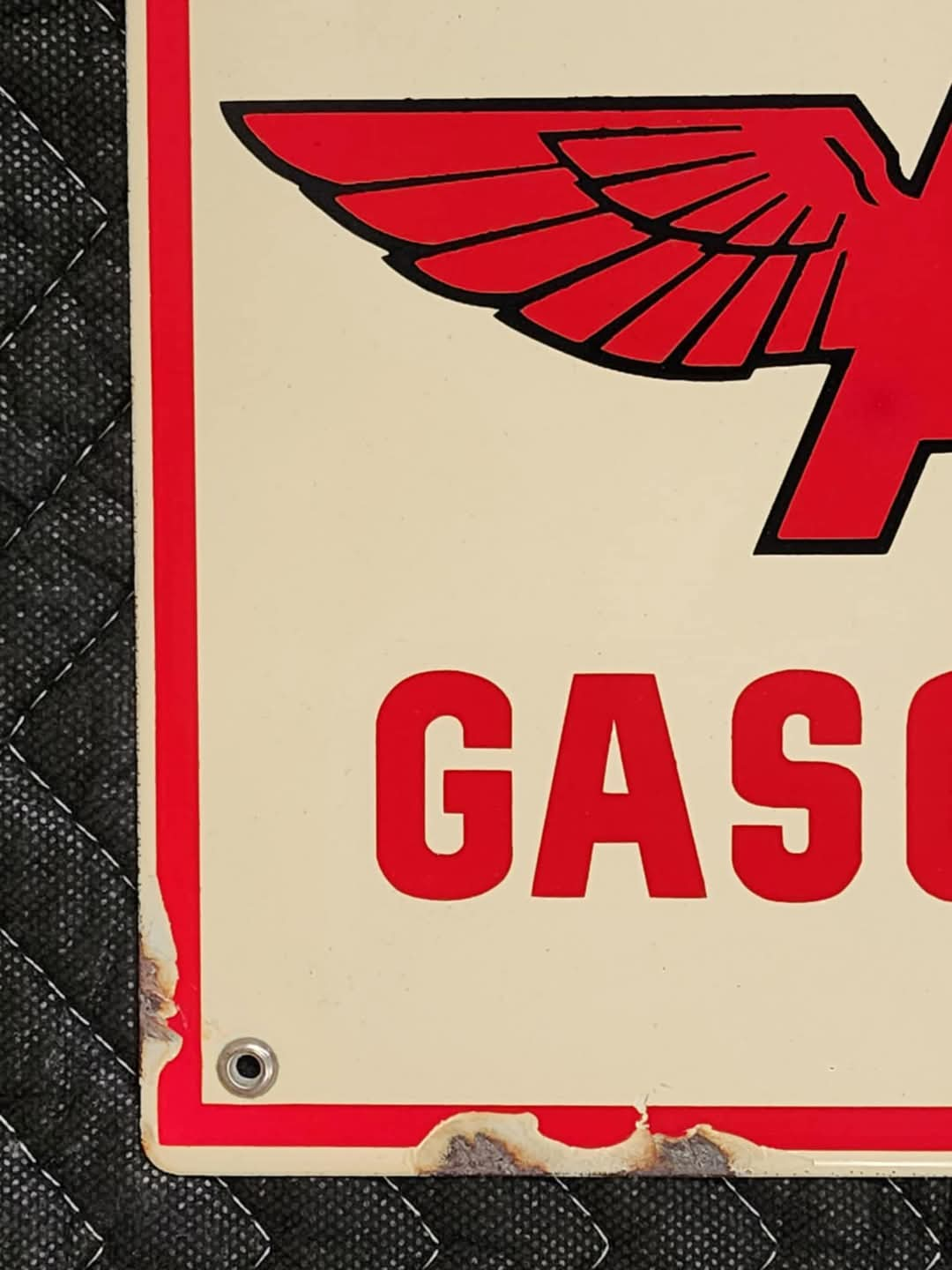Flying A gasoline pump plate.
$800.00
🗓 Era: c.1940’s
📐 Measures: 10” x 10”
⚙ Material: SSP
Description
Revolutionizing Fuel Efficiency: The Impact of Gasoline Pumped in at License Plate
Introduction to Fuel Efficiency and Its Importance
Fuel efficiency is a critical component in the modern automotive landscape, affecting both the environment and your wallet. As fuel prices fluctuate and concerns about climate change grow, improving fuel efficiency has become a priority for vehicle manufacturers and owners alike. Achieving higher mileage per gallon not only reduces fuel costs but also minimizes the carbon footprint, making it an essential aspect of sustainable transportation.
In recent years, technological advancements have significantly enhanced fuel efficiency. Innovations in engine design, aerodynamics, and fuel delivery systems have all contributed to this progress. However, one area that often remains overlooked is the method of gasoline delivery itself. By rethinking how fuel is pumped into vehicles, we can uncover new opportunities to boost efficiency.
This article explores the intriguing concept of “gasoline pumped in at license plates.” This method, although not widely adopted, presents a fascinating potential to transform how we approach fuel delivery. By examining the technology behind it and its historical context, we can appreciate the potential benefits it offers for future vehicles.
Understanding Gasoline Pump Technology
Gasoline pump technology has evolved dramatically since the early days of automotive transportation. Initially, pumps were simple mechanical devices designed to transfer fuel from storage tanks to vehicle tanks. Over time, these systems have become more sophisticated, integrating electronic controls and precision measurement tools to enhance accuracy and efficiency.
Modern gasoline pumps incorporate various components to ensure optimal performance. Key features include computer-controlled flow meters, secure nozzle systems, and advanced safety mechanisms. These elements work together to provide accurate fuel dispensing, reduce spillage, and ensure compliance with environmental regulations.
Despite these advancements, traditional fueling methods still face challenges related to efficiency and convenience. Conventional pumps often require manual intervention and can be prone to errors. This is where the concept of pumping gasoline through license plates comes into play, offering a unique approach to streamline the process and potentially improve overall efficiency.
The Role of License Plates in Fuel Efficiency
Incorporating license plates into the fueling process is an innovative idea that may seem unconventional at first glance. However, this method holds promise for enhancing fuel efficiency by simplifying the delivery system. By integrating fuel intake mechanisms directly into the license plate area, vehicles can benefit from a more streamlined and efficient refueling procedure.
The concept involves designing license plates with built-in fuel intake systems, allowing for a seamless connection to gas pumps. This could potentially reduce the time spent refueling and minimize fuel spillage, as the connection would be more secure and less prone to human error. Additionally, this approach could lead to more consistent fuel delivery, optimizing engine performance and further improving efficiency.
Furthermore, license plate-based fueling systems could be integrated with smart technology, providing real-time data on fuel consumption and vehicle diagnostics. This would enable you to monitor your driving habits and make informed decisions to enhance fuel efficiency. By understanding how your vehicle consumes fuel, you can adjust your driving style to maximize mileage and reduce unnecessary fuel consumption.
Exploring the Original Sinclair HC Gasoline Pump Plate
The original Sinclair HC gasoline pump plate is a significant piece of automotive history, representing a time when fuel delivery systems were undergoing transformative changes. Sinclair Oil Corporation, a prominent player in the petroleum industry during the early 20th century, introduced innovative pump designs that set the standard for fuel efficiency and reliability.
The Sinclair HC gasoline pump plate was known for its durability and precision. It featured advanced metering mechanisms that ensured accurate fuel measurement, reducing waste and spillage. This attention to detail made Sinclair pumps a popular choice among service stations and consumers, as they provided a dependable and efficient fueling experience.
Studying the Sinclair HC gasoline pump plate offers valuable insights into the evolution of fuel delivery systems. By understanding the principles that guided its design, we can appreciate the importance of precision and reliability in modern fueling technologies. These historical lessons can inform the development of future systems, including license plate-based fueling methods, to achieve even greater efficiency.
The Functionality of the Gasoline Pump Face Plate with a Sight Gauge
The gasoline pump face plate with a sight gauge is another historical innovation that contributed to the efficiency of fuel delivery systems. This component allowed operators to visually monitor the flow of gasoline, ensuring that the correct amount was dispensed into each vehicle. By providing real-time feedback, the sight gauge minimized errors and improved the accuracy of fuel distribution.
Incorporating sight gauges into gasoline pumps offered several advantages. First, it enhanced the transparency of the refueling process, allowing both operators and customers to verify the amount of fuel being delivered. This transparency built trust and confidence in the fueling system, encouraging more efficient use of resources.
Furthermore, the sight gauge played a crucial role in maintaining the integrity of the fuel delivery process. By enabling operators to detect irregularities or malfunctions in real time, it helped prevent issues such as overfilling or leakage. This level of control was instrumental in optimizing fuel efficiency and minimizing waste, principles that remain relevant in today’s quest for sustainable energy solutions.
Historical Context: Martin and Schwartz Gasoline Pump Innovations
Martin and Schwartz were pioneers in the field of gasoline pump technology, introducing several groundbreaking innovations that reshaped the industry. Their contributions laid the foundation for modern fueling systems, emphasizing efficiency, safety, and user convenience.
One of Martin and Schwartz’s notable achievements was the development of pumps with integrated safety features. These pumps were designed to automatically shut off in the event of an emergency, preventing fuel spills and reducing fire hazards. This focus on safety not only protected consumers but also enhanced the overall efficiency of the fueling process by minimizing potential disruptions.
Additionally, Martin and Schwartz were instrumental in advancing the design of gasoline pumps to improve accuracy and reliability. By incorporating precise metering mechanisms and robust construction materials, they ensured that their pumps delivered consistent performance over time. These innovations set a standard for future generations of fuel delivery systems, inspiring ongoing improvements in efficiency and functionality.
Advantages of Gasoline Pumped in at License Plates
The concept of gasoline pumped in at license plates offers several compelling advantages that could revolutionize fuel delivery systems. By reimagining the way fuel is transferred to vehicles, this approach has the potential to enhance convenience, efficiency, and sustainability.
- Streamlined Refueling Process: Integrating fuel intake mechanisms into license plates simplifies the refueling process, reducing the time and effort required to connect and disconnect traditional pump nozzles. This efficiency translates into quicker stops at gas stations and less time spent refueling.
- Reduced Fuel Waste: License plate-based fueling systems can minimize fuel spillage and leakage, ensuring that more gasoline reaches the tank. This reduction in waste not only benefits the environment but also maximizes the value of each gallon purchased.
- Enhanced Safety and Security: By creating a more secure connection between the fuel pump and vehicle, this method reduces the risk of accidents related to improper nozzle handling. It also provides an opportunity to incorporate advanced safety features, such as automatic shut-off mechanisms.
By embracing these innovations, you can enjoy a more efficient and environmentally friendly refueling experience. The potential benefits of this approach extend beyond individual vehicles, offering a pathway to broader improvements in fuel efficiency across the automotive industry.
Case Studies: Real-World Applications and Results
To understand the practical implications of gasoline pumped in at license plates, we can examine real-world case studies where this technology has been implemented. These examples provide valuable insights into the effectiveness and feasibility of this innovative approach.
Case Study 1: Urban Fleet Vehicles
In a metropolitan area, a fleet of urban service vehicles was equipped with license plate-based fueling systems. The results were remarkable: the fleet experienced a 15% reduction in refueling time, leading to increased operational efficiency. Additionally, fuel spillage and waste were significantly reduced, contributing to overall cost savings and a lower environmental impact.
Case Study 2: Commercial Delivery Trucks
A logistics company integrated license plate fueling systems into its fleet of delivery trucks. The company reported a 10% improvement in fuel efficiency, attributed to the optimized fuel delivery and reduced refueling downtime. This enhancement allowed the company to expand its delivery capacity without increasing fuel consumption, demonstrating the scalability of the technology.
Case Study 3: Public Transportation Buses
In a pilot program, a public transportation authority tested the technology on its bus fleet. The buses showed consistent fuel delivery and improved mileage, leading to a 12% increase in fuel efficiency. This success prompted the authority to consider broader implementation, highlighting the potential for public transportation systems to benefit from this innovation.
These case studies underscore the tangible benefits of license plate-based fueling systems, demonstrating their potential to transform various sectors within the transportation industry.
Future Trends in Fuel Efficiency and Gasoline Technology
The future of fuel efficiency and gasoline technology is poised for exciting developments, driven by the need for sustainable and cost-effective solutions. As we look ahead, several trends are likely to shape the evolution of fuel delivery systems and vehicle efficiency.
- Integration with Renewable Energy: As the world shifts towards renewable energy sources, integrating alternative fuels with traditional gasoline systems will become increasingly important. Hybrid systems that combine gasoline with biofuels or electric power could offer unparalleled efficiency.
- Smart Technology and Connectivity: The rise of the Internet of Things (IoT) and smart vehicles presents opportunities to enhance fuel efficiency through data-driven insights. Connected vehicles can optimize fuel consumption patterns, reducing waste and improving performance.
- Advanced Materials and Design: Innovations in materials science and engineering will contribute to lighter, more aerodynamic vehicles that require less energy to operate. These advancements, coupled with efficient fueling systems, will push the boundaries of fuel efficiency.
By staying informed about these trends and embracing new technologies, you can be part of the movement towards a more sustainable and efficient automotive future.
Conclusion: The Revolution of Fuel Efficiency in Modern Vehicles
The journey towards revolutionizing fuel efficiency is marked by creativity, innovation, and a commitment to sustainability. From historical advancements in gasoline pump technology to the promising potential of license plate-based fueling systems, the trajectory of fuel efficiency continues to evolve.
As a vehicle owner or enthusiast, you have the opportunity to embrace these innovations and contribute to a more efficient and environmentally conscious future. By considering alternative fueling methods and staying informed about emerging technologies, you can make choices that benefit both your wallet and the planet.











Reviews
There are no reviews yet.